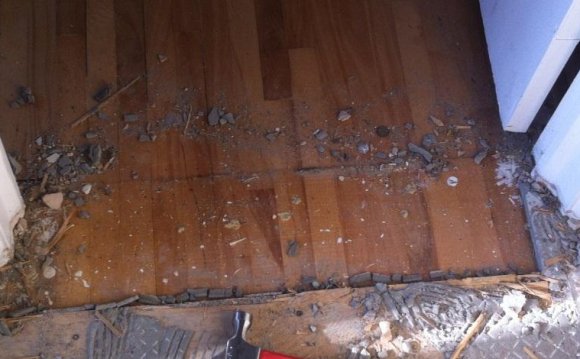

Summary: Wood flooring can become infested with beetle larvae from eggs laid on unfinished wood surfaces. Hatching larvae bore into the wood and can result in extensive damage. Even kiln-dried wood can become infested. Wood flooring can be protected by sealing the surface and/or treating it with borate insecticide.
Jack DeAngelis, PhD OSU Ext. Entomologist (ret.)
|
Wood may even be infested even after it has been kiln-dried (heat dried) and milled into lumber. Infestation occurs when dried wood is improperly stored near an active infestation (see below). Kiln-drying alone does not protect against infestation, it only eliminates larvae that are present at the time the wood entered the dryer. |
Is the infestation still active?This is one of the first questions usually asked. Since emergence holes are permanent it is impossible to know for certain if the infestation is active if you find holes in the floor as pictured above. The best indication of an active infestation is the presence of fine, powdery boring dust associated with emergence holes. Another good indicator is the condition of the emergence holes themselves. Use your hand lens or magnifying glass to look carefully at the emergence holes under a good light. If the walls of the hole are covered with floor finish (below right) you can conclude that the holes were made before the finish was applied and may indicate a old, inactive infestation. On the other hand, if the walls appear fresh you might conclude that beetles emerged recently indicating an active infestation. |
Elongated emergence holes (right) also indicate that the holes were made before the wood was cut into flooring. Emergence holes are normally round, elongated holes occur when a round log is cut at an angle to the original surface. Another way to distinguish active from inactive infestations is to mark all existing holes with a grease pencil so that new ones can be spotted. You probably won't find beetles flying around the room. Control of wood destroying insectsThere are two products that can be used to protect new floors from wood destroying insects and fungi. These products are based on insecticidal borates (see What are Borate Insecticides?). Bora Care and Shell-Guard (see this article) are glycol-based borate products while Timbor (see this article) is a pure borate powder without any glycol additive. Timbor is mixed with water to apply. Some studies indicate that glycol helps to carry the borate into the wood, other studies found no difference. |









